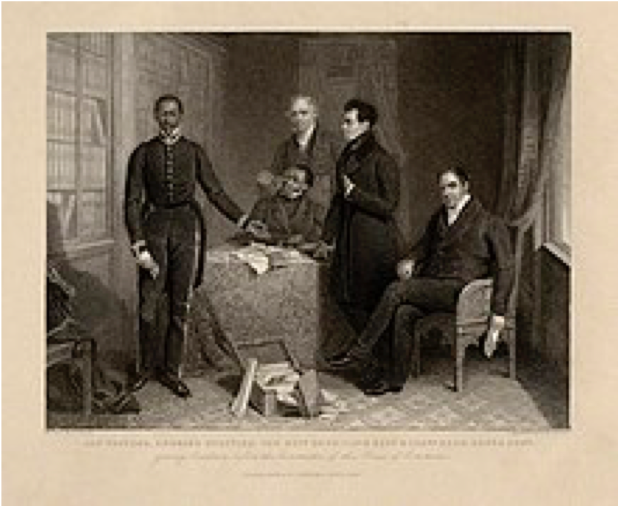In 1837, drawing a colour line

What does this engraving represent? The short answer is, an occasion in 1837 when a British Parliamentary Committee concerned with the rights of people in its colonies was hearing evidence and making its report. People were called to give evidence, including the men shown. The Committee, chaired by Thomas Fowell Buxton, was considering how Britain treated territories that had become its colonies. And specifically, in this particular case it considered whether what was known at the time as the ‘ceded territory‘, now part of the Eastern Cape in South Africa, should be under British colonial jurisdiction, or was to be returned to the black groups who inhabited the area before it was ceded (that is, made an area where neither white nor black people could live).
The engraving shows the men in an antechamber (a back room) in the House of Commons in London, with various of the documentary evidence and in particular the maps that they were speaking to shown in the trunk in front of the table, with other documents and maps on the table top. They are, from left to right standing, Jan Tzatzoe aka Jan Dyani, James Read snr and James Read jnr; and from left to right sitting, Andries Stoffels and John Philip.
Jan Tzatzoe was a Christian convert, and an elder son in a minor branch of the ruling Xhosa hierarchy in the Eastern Cape. In western terms, he was cadet branch royalty. James Read the father was one of the first LMS missionaries to work in South Africa. His son James, whose mother Elizabeth Valentyn was a Khoi woman, was also an ordained LMS missionary and a leading figure in the Kat River Settlement. Andries Stoffels was a church Deacon in the Kat River Settlement. Dr Phillip was titular head and main administrator of the LMS missionary presence in South Africa.
What happened? In a nutshell, the ceded territory was returned to black governance and the Cape Governor of the day, Benjamin D’Urban was recalled. This decision, after yet more frontier wars, was changed later, but for a brief period things were different.
For a more detailed discussion of the matters discussed in this blog, please see the Trace which develops it.
Last updated: 12 August 2021





